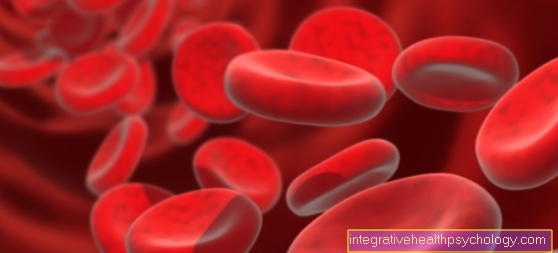Vasectomy - The sterilization of the man
introduction
The vasectomy is the sterilization of men and is also known as vasoresection in specialist circles.
The vasectomy is a minor surgical procedure that prevents the sperm produced in the testes from being released into the semen (Ejaculate) by cutting the vas deferens. The sperm that will continue to be produced after the vasectomy will be broken down by the body.

Reasons for a vasectomy
The main reason for choosing a vasectomy is to use contraception.
If a couple has finished planning their children, or if they are sure that they do not want to have children, sterilization is a very reliable method of contraception. In principle, sterilization can be carried out on the woman or the man. In favor of a man's vasectomy, however, is the fact that it involves significantly less risk and effort than sterilization of women, which has to be performed under general anesthesia.
Typically, men who have a vasectomy are 30 years old or older and have children.
A vasectomy can also be useful from a medical point of view if, for example, there is a serious genetic disease and you want to rule out passing it on.
How does a vasectomy work?
In most cases, the vasectomy is performed on an outpatient basis and under local anesthesia. In exceptional cases, the procedure can also be performed under general anesthesia if the patient so wishes. As a rule, the procedure is carried out by a specialist, a so-called urologist.
First, the skin of each scrotum is opened with a short incision. The spermatic duct on each side is pulled out a little through the corresponding hole and cut through. At the same time, a section of the vas deferens is removed.
The resulting ends are then either sewn together or destroyed by electric shocks. The different ends of the vas deferens are then placed in different layers of the tissue so that the risk of the ends growing back together is minimized. Most of the time, the cuts in the scrotum are so small that it is not necessary to sew the skin together, but rather the wound heals by itself.
Can a vasectomy also be performed on an outpatient basis?
Usually, the vasectomy is performed on an outpatient basis because it is only a minor procedure. It can be performed in a urological practice or a hospital outpatient department. It is advisable to have someone to accompany you on your way home.
Are there different vasectomy methods?
There is the so-called non-scalpel vasectomy, which has the lowest complication rate. In this procedure, the skin is only scratched and then spread apart to get to the vas deferens. In conservative vasectomy, a skin incision about 1 cm long is made with a scalpel to access the spermatic cord. In this method, a small piece of the vas deferens is cut out. With regard to the safety of contraception, no difference has been found between the two methods.
Meanwhile there is also the non-needle-non-scalpel method. In principle it works like the non-scalpel method. Only the local anesthetic is not done with a syringe, but with a needleless anesthetic technique. In this case, the anesthetic is pressed into the skin by means of air pressure.
Vasectomy without a scalpel - is that possible?
In the meantime, a process has been developed that does not require the use of a scalpel. One speaks of the non-scalpel vasectomy.
Here the spermatic duct is pulled out through just one or a maximum of two skin openings, cut and then repositioned in its original position. Special instruments have been developed for this, so that the procedure no longer requires a skin incision with a scalpel. The small opening in the skin does not have to be sewn, a plaster is sufficient. As with conservative vasectomy, anesthesia is administered via a syringe with a local anesthetic.
Compared to the conservative method, the non-scalpel has a lower complication rate, less pain and faster recovery.
How long does a vasectomy take?
The surgical procedure for a vasectomy usually takes about 20 to 30 minutes. In addition, there is the time for the preparation, i.e. the introduction of the local anesthetic and the preparation and disinfection of the skin areas that are cut open.
Which doctors do a vasectomy?
The vasectomy is performed by a urologist.
A urologist treats diseases of the bladder and the urinary system on the one hand, but also diseases of the male genital organs, such as the testicles or the prostate, on the other.
Preparation for the vasectomy
The main part of preparation is a very detailed consultation with the specialist.
The man who wishes to have a vasectomy will be informed in detail about the procedure and all possible risks and after-effects explained. The decision to have a vasectomy is often made jointly by couples who no longer wish to have children or who have finished planning their children, or who generally do not wish to have children.
What to look for after the vasectomy
In order to protect the testicles and its wounds after the procedure, a few days are usually sufficient, in which the man should take it easy and should not be sexually active. In some cases it makes sense to wear testicle protection during this time.
In the first few months after the procedure, fertilizable sperm may still be present in the man's sperm, so an additional method of contraception should be used during this time. To check the success of the vasectomy, the sperm fluid is checked regularly 2 to 3 months after the operation for fertilizable sperm, a so-called spermiogram. As a rule, the sperm still contains up to 20 ejaculations of fertilizable sperm.
In addition, in the first few months after the vas deferens have been cut, the ends of the vas deferens may reconnect. This is another reason why the semen should be checked for sperm during this time. So-called recanalization can still occur several years after the vasectomy.
How long will you be unable to work after a vasectomy?
If there are no complications, you can go back to work after just two days. Sports activities should be avoided for about one to two weeks. Depending on your own well-being, you can then start again with the sport.
In the event of complications, especially epididymitis, you have to pause significantly longer with sport and work.
What is the cost of a vasectomy?
Since in most cases a vasectomy is not an intervention that is medically necessary, the costs are generally not covered by statutory or private health insurance companies.
The patient has to bear the costs himself, which total around 300 to 600 euros. These values can vary depending on the type of anesthesia and the practice in which the procedure is performed. It should be clarified in advance whether the stated costs relate only to the procedure itself or whether the consultation discussions beforehand and the subsequent aftercare also include.
Please also read: Cost of a vasectomy
What are the side effects and complications of a vasectomy?
Since it is only a minor procedure, there are usually very few side effects and complications.
The wounds of the testicle can cause pain, but most of the time it goes away on its own after a few days. In rare cases, wound healing disorders such as bleeding, wound infections and bruises (hematomas) in the testicle area can occur. The inflammation can also spread to the epididymis. In addition, the vas deferens can become inflamed.
A very rare consequence of the procedure is chronic pain in the testicle area. They can intensify during sexual activity and represent a significant restriction in sexual and everyday life. This pain can be caused by lumpy accumulations of sperm (sperm granulomas). They can arise because the sperm production is not yet reduced immediately after the procedure and the sperm cannot be broken down by the body sufficiently quickly. This leads to the expansion of the epididymis, which can be felt as a pea-sized hardening in the testicle.
Read more on the subject at: Sperm granulomas
This rarely results in recanalization of the vas deferens, i.e. an unwanted connection of the two previously severed ends, which can result in renewed fertility in the man.
Recanalization occurs in up to 1% of cases and is demonstrated by functional sperm cells in the seminal fluid a few months after the procedure. In these cases, another intervention is necessary to achieve the male sterility.
The procedure can also lead to psychological problems in men due to infertility. This is especially the case if the procedure was not carefully thought out and the man was not aware of the consequences.
In addition, in rare cases, various nerves can be damaged during the operation, which can impair various functions or sensations.
In order to avoid further complications, men who already have problems in the testicle, groin or lumbar spine area before the operation should inform their doctor beforehand.
The most serious complication is the loss of the testicle. Very rarely, the testicle has to be removed if blood vessels have been injured or an epididymitis can no longer be treated with other methods. Furthermore, in rare cases the vasectomy cannot lead to the inability to conceive if the vas deferens has not been severed or the two severed ends grow back together.
Find out all about the topic here: Side effects of a vasectomy
Is a Vasectomy Painful?
The vasectomy is usually only performed with the help of a local anesthetic, which is completely sufficient.However, the syringes with which the local anesthetic is set can be perceived as uncomfortable. During the procedure, some men may feel a slight pull.
Wound pain is usually felt for about two days after the procedure. This can be done well with painkillers, e.g. with ibuprofen. The incision is very small at about one centimeter and the skin of the testicle is also relatively insensitive, which is why severe pain is not to be expected.
Sometimes the pain can last longer, but often it only occurs with certain movements and should be gone after two weeks. Sexual activity can usually be resumed after seven days.
You can find out whether and what kind of pain you can expect after a vasectomy in our article: Pain after a vasectomy
Epididymitis after a vasectomy
Epididymitis occurs at a frequency of 0.5-5% after a vasectomy.
With the non-scalpel method it is a little less common than with the conservative vasectomy. The epididymitis is very painful and must be treated by a doctor in any case.
An epididymitis leads to swelling, overheating and reddening of the scrotum. Usually the inflammation is accompanied by a high fever. Bed rest for a few days should be observed for treatment. Painkillers can also be taken. In some cases an antibiotic is necessary.
Men who have had one or more epididymis before a vasectomy should discuss this with their doctor before having a vasectomy.
Also read: Pain in the testicle
Are there any long-term consequences that can occur?
In most cases, a vasectomy is unlikely to have long-term consequences.
Occasionally, however, post-vasectomy syndrome can occur. Figures on the frequency of this syndrome vary greatly. The syndrome is understood to be chronic pain in the groin, testicles or epididymis without any inflammation.
The pain has been associated with the vasectomy. There are various approaches to explaining this chronic pain, but a clear cause has not yet been found. Psychological aspects are also discussed as a factor. The severity of the pain ranges from occasional pulling to disabling chronic pain.
Does a vasectomy have an increased risk of cancer?
Although there are studies that claim that there is a slightly increased risk of prostate cancer, there are also studies that did not determine an increased risk. An increased risk cannot be explained scientifically. Studies have not shown an increased risk of testicular cancer or other tumor diseases.
How certain is the result after a vasectomy?
The probability that fertility will still be present after a vasectomy is between 0.1 and 0.15%.
Other methods of contraception cannot be dispensed with immediately after the procedure, as the sperm cells remain in the spermatic cord for weeks or months. Only after several weeks and repeated evidence that there are no more sperm in the ejaculate can other contraceptive methods be dispensed with.
Fertility After Vasectomy
The man's fertility is prevented by the process of vasectomy. With a success rate of more than 99% of the cases, the men can be regarded as sterile a few weeks after the operation.
Fertility can possibly be restored by reversing the transection of the vas deferens. But this is no guarantee that the man will be able to father children again.
Under certain circumstances, for example in cancer patients who want to have children, sperm samples can be frozen before the vasectomy. This enables the woman to be fertilized with the man's sperm even after the vas deferens have been separated.
What happens to sperm production?
Sperm is made up of several components. The sperm and secretions are usually the main components. Sperm is still produced after a vasectomy, but the sperm component is missing. The secretion is produced by sex glands and released through the urethra. The sperm duct, which clogs the sperm with the sperm, also opens into the urethra. If the spermatic duct is severed after a vasectomy, the sperm can no longer enter the urethra and only the secretion is introduced there. In the case of an ejaculation, the secretion that is released usually prevents fertilization.
Read more on the topic: Sperm
Does a vasectomy affect testosterone production?
A vasectomy does not affect testosterone production. Because in a vasectomy only the spermatic cord is severed so that the sperm can no longer get into the ejaculate. Testosterone and sperm continue to be produced in the testes.
The sperm remaining in the testicles are then broken down by the body itself. However, the thesis is discussed that the longer sperm remain in the epididymis after a vasectomy, the testosterone production is no longer stimulated so strongly and thus the testosterone level is not as high after a vasectomy as before.
Does a vasectomy affect the desire for intimacy?
The need for intimacy does not suffer from the intervention of the vasectomy. The production of the male sex hormone testosterone is not affected and the function of the testicles is maintained. The ejaculate also hardly differs from the ejaculate before the procedure, as the sperm only make up about 5% of it.
Therefore, the procedure does not have a negative effect on the sensation of pleasure, erectile function, orgasm of the man and ejaculation. Many couples even rate the procedure as having a positive effect on intimacy as a partner, as there is no longer any need to think about appropriate contraception.
What are the alternatives to a vasectomy?
As an alternative for men to contraception, there is only the condom in addition to the vasectomy. A pill for men has been researched for many years, but has so far been unsuccessful.
If both methods are rejected, contraception would have to be given to the woman.
Women most often use contraception using the pill. There is also the coil, the hormone ring or the female condom. Sterilization for women is a larger procedure than for men and is carried out under general anesthesia. This means that the risk of complications is significantly higher.
Read more on the topic: Contraceptive methods
Can you reverse a vasectomy?
It should be noted that the decision to have a vasectomy is usually a final decision.
Nowadays, however, there are the most modern microsurgical procedures, which in most cases make it possible to reconnect already severed vas deferens. This process is known as vaso-vasotomy or refertilization and can be performed several years after the vas deferens have been severed.
The ends of the vas deferens that were previously separated are sewn back together in this case. For this purpose, the scarred ends are removed beforehand. The process is much more complex than the vasectomy and is carried out with the help of a surgical microscope. Overall, the procedure takes about 2 to 4 hours and is performed under general anesthesia.
The additional effort is also reflected in the costs of the operation, which are significantly higher than those of the transection. However, it is not guaranteed that the man's fertility will be restored, as the body's sperm production can be restricted depending on the time passed.
More on this topic: How can you reverse a vasectomy?























.jpg)





